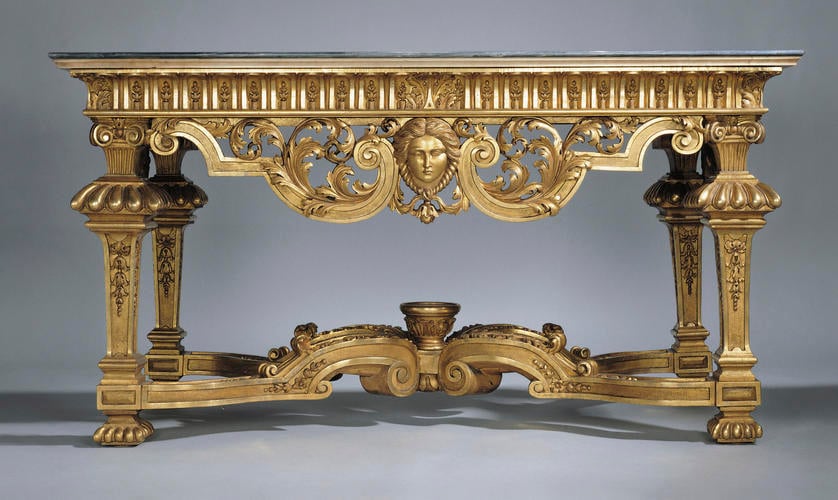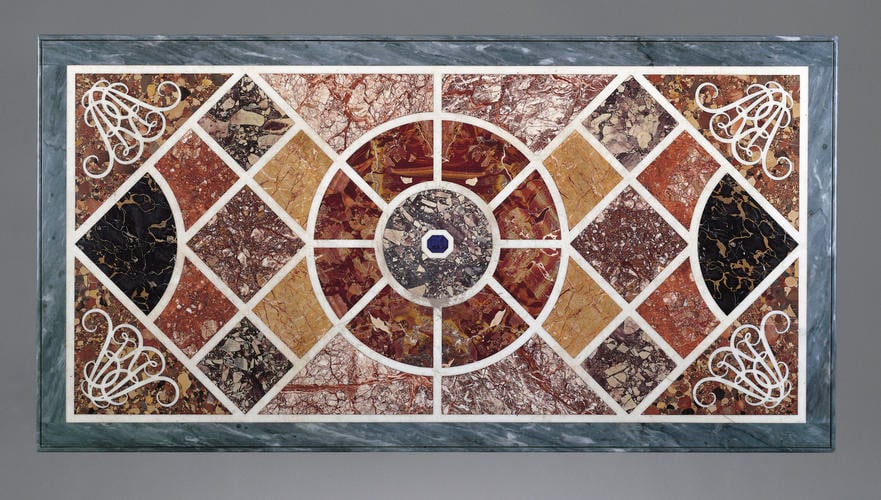-
1 of 253523 objects
Pier table c.1704-5
Gilded pine and beech, inlaid marble | 82.5 x 154.0 x 80.0 cm (whole object) | RCIN 600
-
Rectangular side table, carved and gilded with a multi-coloured marble mosaic top. Frieze decorated with stylised flowers, apron of pierced foliate decoration with central female mask. On four baluster legs with gadrooned collar, joined by X-stretcher with central finial.
Thomas Pelletier, son of Jean and younger brother of René (d. 1726), was appointed Cabinet Maker in Ordinary to Queen Anne in 1704. In spite of this royal appointment, and Jean Pelletier's royal commissions, very little furniture by any member of the Pelletier family has until now been satisfactorily identified. Recently a number of pieces linked by style and documentary evidence, mostly still in the Royal Collection, have been grouped together, and a picture has begun to emerge of the Pelletiers' work for the Crown in the first decade of the eighteenth century.
Thomas Pelletier's apparent anonymity may be due in part to his having worked as a sub-contractor (with his brother René) for the older royal cabinet-maker, Gerrit Jensen. For example, a pair of highly sophisticated gilt stands for Japanese cabinets, which seem certain to have been carved by the Pelletiers, were probably supplied by Jensen to Queen Anne for Kensington Palace in c.1704 ). Several other pieces bearing Queen Anne's monogram are likely to have been supplied in the same manner, including this table. Although it has not been possible to identify a specific order for this table, the fine specimen marble top inlaid with Queen Anne's monogram at the four corners could be related to the 'Marble inlayd Table upon a Carved guilded frame' supplied for Queen Anne at Kensington by the sculptor John Nost in 1704 and valued at £80.
The pier table was removed by George IV from Kensington Palace - either from the King's Gallery or from the Queen's Drawing Room - to help furnish the newly created Private Apartments at Windsor Castle in the late 1820s. After the stripping of the original surface (confirmed during recent conservation), complete regessoing and somewhat metallic regilding by Morel & Seddon, it joined a group of early eighteenth-century giltwood taken from Kensington and Hampton Court Palaces as part of the highly eclectic furnishing of the Grand Corridor.
Catalogue entry from Royal Treasures, A Golden Jubilee Celebration, London 2002Provenance
Made for Queen Anne, circa 1705. Recorded as from "the Gallery at Kensington Palace". May be identified with either a pier table from the Admiral's Gallery or another from the King's Gallery, Kensington Palace.
The Pelletier family of carvers and gilders left France in the early 1680s, probably to escape persecution as Huguenots, and settled in Amsterdam. By 1682 Jean Pelletier was established in London and by the end of the decade his two sons René and Thomas had joined him. Their introduction to royal service was due to the patronage of the francophile Duke of Montagu, the courtier responsible, as Master of the Great Wardrobe, for the furnishing of all royal palaces. Montagu held office from 1671 to 1685 and from 1689 to 1709. For tables, mirrors and stands - the principal furniture types in which they specialised - the Pelletiers drew heavily on the designs of French contemporaries employed by Louis XIV; the engraved furniture of Jean Le Pautre (1618-82) and his son Pierre (1660-1744), for example, finds numerous echoes in the Pelletiers' work for the English Crown. On the technical side, the Pelletiers introduced many subtleties and refinements to the preparation, cutting, gilding and burnishing of carved surfaces. In the rare cases where gilded surfaces survive unscathed, such innovations suggest an attempt to simulate the decorative effect of gilded metal.
Later part of the group of furniture and furnishings supplied between 1827 and 1829 to King George IV by the partnership of Morel and Seddon for The Long Gallery (now the Grand Corridor) at Windsor Castle.
Nicholas Morel had formerly worked for The Prince of Wales, later George IV, at Carlton House and the Royal Pavilion at Brighton. Subsequently, he was commissioned to design and furnish the newly built apartments designed by Sir Jeffry Wyattville (1766-1840) for the King at Windsor Castle. In order to fulfil the contract he entered into partnership with George Seddon III whose family had large and long established furniture workshops in Aldersgate Street in the City of London. -
Creator(s)
(restorer)(nationality)Acquirer(s)
-
Medium and techniques
Gilded pine and beech, inlaid marble
Measurements
82.5 x 154.0 x 80.0 cm (whole object)
Category
Object type(s)
Other number(s)


